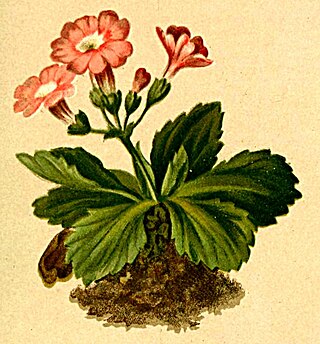
Primula vulgaris, the common primrose, is a species of flowering plant in the family Primulaceae, native to western and southern Europe, northwest Africa, and parts of southwest Asia. The common name is primrose, or occasionally common primrose or English primrose to distinguish it from other Primula species also called primroses. None of these are closely related to the evening primroses.

Campanula carpatica, the tussock bellflower or Carpathian harebell, is a species of flowering plant in the family Campanulaceae.

Primula meadia, the shooting star or eastern shooting star, is a species of flowering plant in the primrose family Primulaceae. It is native to the eastern United States and Canada, spanning north from Manitoba and New York, south to Texas and Florida.

Cortusa is a formerly recognized genus in the family Primulaceae. It is now regarded as a synonym of the genus Primula. It consisted of about 19 species of delicate, hardy, alpine perennials. The genus was named by the herbalist Matthiolus after his friend Cortusus, professor of botany at Padua, who discovered the plant originally called Cortusa matthioli (now Primula matthioli. The plants are flowering herbaceous perennials native to the mountains of southern and eastern Europe, including the Alps and the Carpathians, with some species native to China. Most of the species are small spring bloomers for shade and rock garden. These low-growing and rather handsome little plants have clumps of downy, light green, heart-shaped leaves with serrated edges. In late spring, small loose umbel of delicate bell-shaped to lily-liked flowers born terminally on drooping spikes arise from the base, some 6-8in high. Flowers are magenta, pink, white and yellow. They are dormant in some months, and as spring begins, stems and leaves quickly start to reproduce.

Androsace vitaliana is a species of plant in the primrose family, Primulaceae. It was previously known by the synonym Vitaliana primuliflora. Native to the high mountains of Europe, it is cultivated as an alpine garden plant, being considered easy to grow in well drained soil in a sunny position.

Primula angustifolia, also known as alpine primrose, is a species of flowering plant in the family Primulaceae, native to the Rocky Mountains of the United States. It is commonly found in Colorado and New Mexico.

Primula nutans, also known as the sleepy primrose, is a species of flowering plant belonging to the family Primulaceae.

Primula stricta, also known as the strict primrose, is a species of flowering plant in the family Primulaceae.

Primula scandinavica is a species of flowering plant in the family Primulaceae.

Primula algida is a species of flowering plant within the family Primulaceae. This species was first described by Michael Friedrich Adams.
Primula minor is a species of flowering plant within the family Primulaceae. It was first described by Isaac Bayley Balfour and Frank Kingdon-Ward in 1915. It is a close relative of the species Primula graminifolia.

Thunbergia battiscombei, also known as the blue glory vine, is a species of flowering plant within the family Acanthaceae. It is sometimes used as an ornamental garden plant for its beautiful large blooms and leafy foliage. Thunbergia battiscombei is also cultivated as a herb within its native range. Some people superstitiously believe the herb is able to help remedy mental imbalance, curses and black magic.

Primula aureata is a species of flowering plant from the family Primulaceae.

Telekia speciosa, also known as the heart-leaved oxeye or yellow oxeye, is a species of flowering plant within the family Asteraceae.

Primula daonensis is a species of Primula within the family Primulaceae.
Primula heucherifolia is a species of flowering plant in the family Primulaceae.
Primula boveana, also known as the Sinai primrose, is a species of flowering plant within the family Primulaceae. The species was named in honour of botanist and plant collector Nicolas Bové.

Primula glutinosa, also known as the sticky primrose, is a species of flowering plant within the family Primulaceae.

Primula borealis, also known as the Northern primrose or slender primrose, is a species of flowering plant within the genus Primula and family Primulaceae. The species is a halophyte, inhabiting coastal saline habitats within subalpine and subarctic regions.

Primula clarkei is a species of flowering plant within the genus Primula and family Primulaceae. The species is endemic to the Western Himalayas, where it can be found in Poshiana of the Pir Panjal mountain range.
















